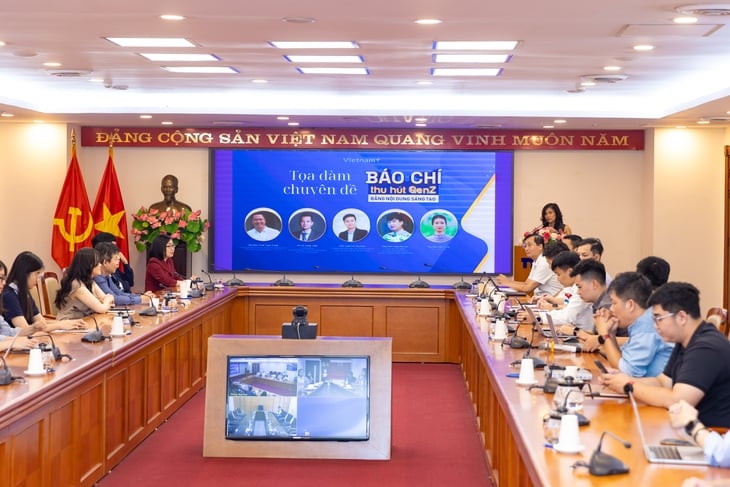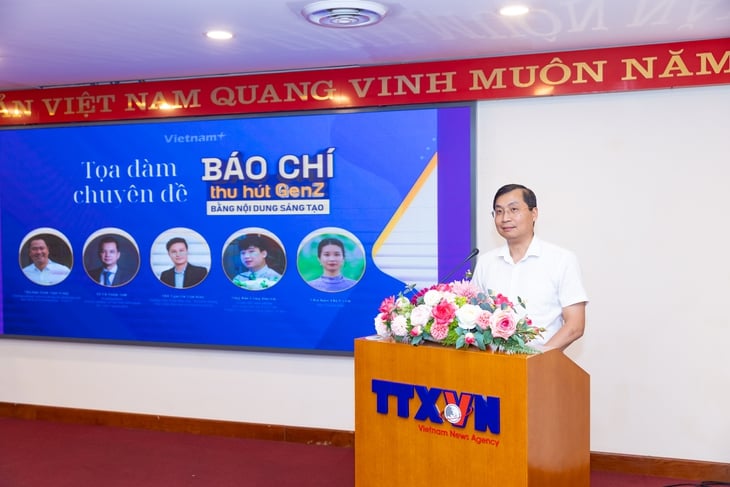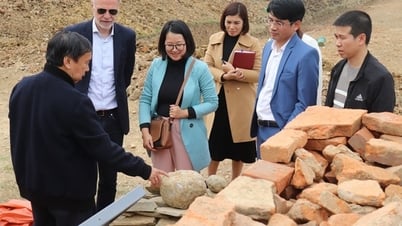
The seminar "Press attracts Gen Z with creative content" provided a lot of useful information for building and developing readership attraction strategies of press agencies - Photo: MINH SON
Generation Z (Gen Z) is a tech-savvy audience, born in the digital age.
A survey from Statista shows that 50% of Gen Z receives information from social networks every day and only uses mobile phones to receive information.
They are creating daily digital consumption habits when accessing news. Gen Z is becoming one of the largest media consumer groups today.
Gen Z readers are not a "rush" generation but are strict about content.
At the seminar "Press attracts Gen Z with creative content", organized by VietnamPlus e-newspaper on the afternoon of June 17 in Hanoi , Mr. Tran Tien Duan - editor-in-chief of VietnamPlus e-newspaper, cited recent studies showing that social networks such as Facebook, TikTok, and Zalo are taking up most of the time of young users, causing traditional information channels such as newspapers and television to gradually lose their influence.
He also notes that Gen Z tends to prefer quicker, shorter, and more direct media consumption, and is only interested in news around topics that interest them.
"Readers in general and Gen Z in particular have increasingly stricter requirements for content quality and new and attractive multimedia experiences," Mr. Tran Tien Duan affirmed.
The development of new technology platforms and social networks is also posing significant challenges in terms of operating models, competitiveness and maintaining revenue sources for press agencies.
Therefore, proactively grasping trends, applying advanced technology and innovating in content production and distribution is a "vital" requirement to attract a diverse audience.

Mr. Tran Tien Duan, editor-in-chief of VietnamPlus electronic newspaper - Photo: MINH SON
Faced with rapid development and change, looking directly at the current state of journalism, journalist Tran Ngoc Long - head of the communications and multimedia department of VietnamPlus e-newspaper - commented that many generations of reporters and journalists trained in traditional methods are not ready for multimedia journalism. Some even have limited basic digital skills.
“Traditional journalism focuses primarily on text-based reporting. While powerful, this format often struggles to hold viewers’ attention in today’s world of visual stimulation,” said journalist Tran Ngoc Long.
Journalists today have many "weapons" to tell their stories. Those weapons are not only text but also photos, videos , graphics or data. This is considered a competitive advantage, when modern readers, especially Gen Z, prefer visual, interactive and multi-platform forms of journalism more than traditional journalism based only on text.
Typical video formats like 9:16 vertical or 16:9 horizontal are very popular. In fact, the "Piece of News" trend is on the rise, showing that long news/articles or long clips do not necessarily attract many views.
Not only digital transformation in form but also transformation in thinking
While previous generations patiently read long articles on paper or computer screens, Gen Z prefers short videos, animated images, memes, and anything that catches the eye in the first 3 seconds. They grew up in a world of TikTok, YouTube Shorts, Instagram Reels - where news is no longer text, but a multimedia experience.
Dr. Vu Tuan Anh, head of the Department of Communication and Foreign Culture, Diplomatic Academy, analyzed: "We not only need to "digitally transform" in form, but also need to transform the mindset of journalism - from "one-way reporting" to "multi-dimensional communication", so that Gen Z does not just read the news but also experiences the news".
Journalism can translate Gen Z language into friendly language, instead of the somewhat serious expressions of traditional journalism, to make journalism accessible to Gen Z without losing accuracy; telling stories with images, sounds, and movements, not just text.
"Gen Z today is very skeptical, mainstream media needs to act as a gatekeeper. To build trust, which will lead to young people having the habit of verifying information and fighting fake news," said Dr. Vu Tuan Anh.
The press plays both the role of transmitting information and creating community. Gen Z always wants to be a participant, share and create content. The press needs to help this group of readers have practical social activities, optimizing their role in life.
A recent survey by VietnamPlus online newspaper with 764 young people surveyed showed that Gen Z accesses information in the digital space via smartphones (83.9%), while computers (desktop and laptop only 12%), the rest are via tablets.
Gen Z's favorite areas in digital space are: society 66.8%, culture (66%), life (63.6%), travel 40.7%, self-development (56.2%), love, family affection (50%).
Regarding the need for information access, video accounts for 78.4%, images (67.8%), short articles (64.7%), Podcasts (27.5%), multimedia products (28.8%), and graphics (23.8%).
Nic Newman's research in Journalism, Media, and Technology Trends and Predictions 2024 shows that video-based platforms are changing the way communication is done, with short, visual content becoming the priority.
Social networks like Facebook, TikTok, and Zalo are taking up most of young users' time, while traditional information channels like newspapers and television are increasingly losing their influence.
Source: https://tuoitre.vn/tren-bao-chi-nhom-doc-gia-gen-z-yeu-cau-ngay-cang-khat-khe-ve-chat-luong-noi-dung-2025061801034563.htm



































































































Comment (0)